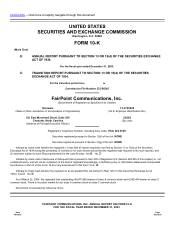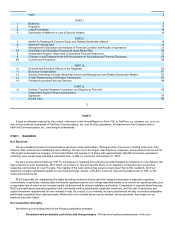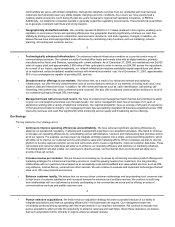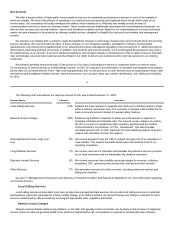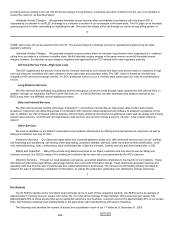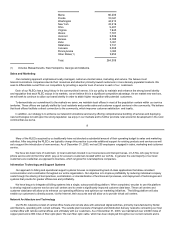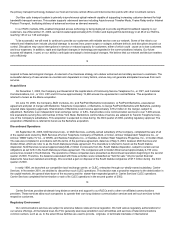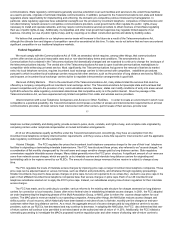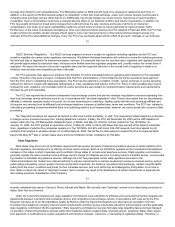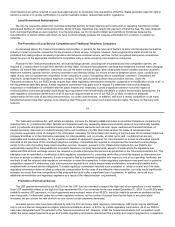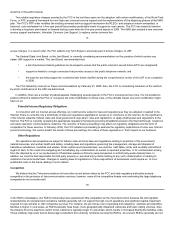FairPoint Communications 2003 Annual Report Download - page 7
Download and view the complete annual report
Please find page 7 of the 2003 FairPoint Communications annual report below. You can navigate through the pages in the report by either clicking on the pages listed below, or by using the keyword search tool below to find specific information within the annual report.
the primary transport technology between our host and remote central offices and interconnection points with other incumbent carriers.
Our fiber optic transport system is primarily a synchronous optical network capable of supporting increasing customer demand for high
bandwidth transport services. This system supports advanced services including Asynchronous Transfer Mode, Frame Relay and/or Internet
Protocol Transport, facilitating delivery of advanced services as demand warrants.
In our RLEC markets, DSL-enabled integrated access technology is being deployed to provide significant broadband capacity to our
customers. As of December 31, 2003, we had invested approximately $13.3 million and deployed this technology in all 26 of our RLECs,
reaching 123 of our 143 exchanges.
To be successful, we will need to continue to provide our customers with reliable service over our network. Some of the risks to our
network and infrastructure include: physical damage to access lines; power surges or outages; software defects; and disruptions beyond our
control. Disruptions may cause interruptions in service or reduced capacity for customers, either of which could cause us to lose customers
and incur expenses. In addition, rapid and significant changes in technology are expected in the communications industry. Our future
success will depend, in part, on our ability to anticipate and adapt to technological changes. We believe that our network architecture enables
us to efficiently
9
respond to these technological changes. An element of our business strategy is to deliver enhanced and ancillary services to customers. The
successful delivery of new services is uncertain and dependent on many factors, and we may not generate anticipated revenues from such
services.
On December 1, 2003, the Company purchased all of the capital stock of Community Service Telephone Co., or CST, and Commtel
Communications, Inc., or CCI. CST and CCI serve approximately 13,280 access line equivalents in central Maine. This acquisition is
referred to herein as the Maine acquisition.
On June 18, 2003, the Company, MJD Ventures, Inc. and FairPoint Berkshire Corporation, or FairPoint Berkshire, executed an
agreement and plan of merger with Berkshire Telephone Corporation, or Berkshire, to merge FairPoint Berkshire with Berkshire, pending
required state regulatory approvals. Shareholders of Berkshire would receive approximately $19.2 million in the merger, subject to
adjustment. Berkshire is an independent local exchange carrier, or ILEC, that provides voice communication services to over 7,200 access
line equivalents serving five communities in New York State. Berkshire's communities of service are adjacent to Taconic Telephone Corp.,
one of the Company's subsidiaries. This acquisition is expected to close during the third quarter of 2004, pending regulatory approval. The
acquisition of Berkshire is referred to herein as the Berkshire acquisition.
On September 30, 2003, MJD Services Corp., or MJD Services, a wholly-owned subsidiary of the Company, completed the sale of all
of the capital stock owned by MJD Services of Union Telephone Company of Hartford, or Union, Armour Independent Telephone Co., or
Armour, WMW Cable TV Co., or WMW, and Kadoka Telephone Co., or Kadoka, to Golden West Telephone Properties, Inc., or Golden West.
The sale was completed in accordance with the terms of the purchase agreement, dated as of May 9, 2003, between MJD Services and
Golden West, which we refer to as the South Dakota purchase agreement. The divestiture is referred to herein as the South Dakota
disposition. MJD Services received approximately $24.2 million in proceeds from the South Dakota disposition, subject to certain escrow
obligations as set forth in the South Dakota purchase agreement. The companies sold to Golden West served approximately 4,150 voice
access lines located in South Dakota. The operations of these companies were presented as discontinued operations beginning in the second
quarter of 2003. Therefore, the balances associated with these activities were reclassified as "held for sale." All prior period financial
statements have been restated accordingly. We recorded a gain on disposal of the South Dakota companies of $7.7 million during the third
quarter of 2003.
In early 1998, we launched our competitive local exchange carrier, or CLEC, enterprise through our wholly-owned subsidiary, Carrier
Services. In November 2001, we decided to discontinue such CLEC operations. This decision was a proactive response to the deterioration in
the capital markets, the general slow-down of the economy and the slower-than-expected growth in Carrier Services' CLEC operations.
Carrier Services completed the termination or sale of its CLEC operations in the second quarter of 2002.
10
Carrier Services provides wholesale long distance service and support to our RLECs and to other non-affiliated communications
providers. These services allow such companies to operate their own long distance communication services and sell such services to their
respective customers.
Our communications services are subject to extensive federal, state and local regulation. We hold various regulatory authorizations for
our service offerings. At the federal level, the FCC generally exercises jurisdiction over all facilities and services of telecommunications
common carriers, such as us, to the extent those facilities are used to provide, originate, or terminate interstate or international

